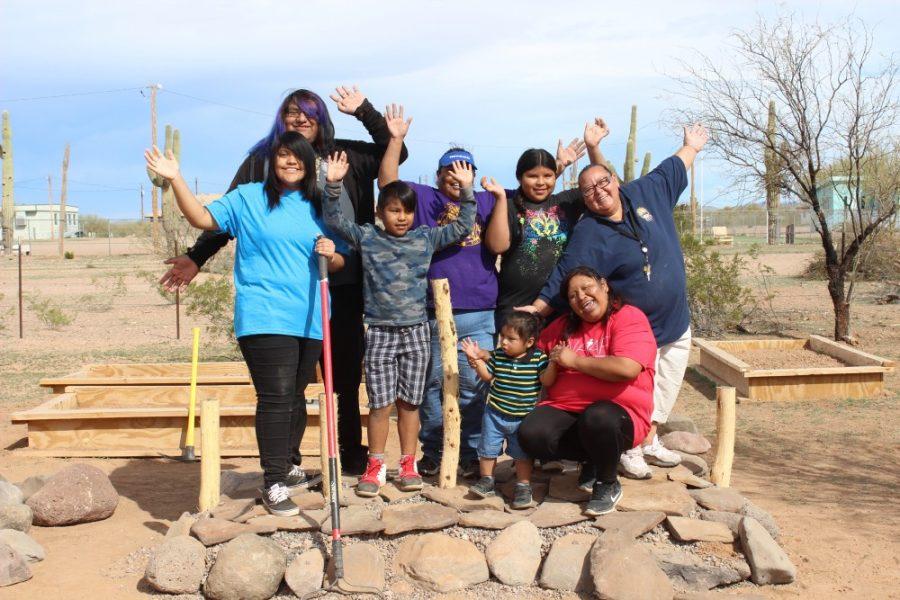President Donald Trump’s proposed wall will undoubtedly divide American and Mexican communities that are split along the borderlands. However, a separate nation that has spanned this border for centuries prior to its creation is imminently under attack.
According to the Tohono O’odham Nation’s website, there are approximately 28,000 people in its tribe. The Native American community occupies a vast 2.8 million-acre area in the Sonoran Desert. Although a large majority of the tribe’s population lives in the Arizona portion of the reservation, thousands of Tohono O’odham people live in the southern part of the land in the Mexican state of Sonora.
The frustrations about the future of their nation tend to focus on federal funding and policy decisions. However, two organizations have teamed with the Tohono O’odham people to bring a force of positivity and hope to the community.
GreaterGood.org and the Native American Advancement Fund collaborated with the Gu Vo community to help build an Earthbench, a sustainably-built public bench that functions as a both a sitting area and a powerful cultural symbol. Completed Feb. 20, the bench joined over 50 other benches around the world in 15 different countries as part of the Peace on Earthbench Movement.
San Francisco-based artist Brennan Bird came to the Tohono O’odham nation to help construct the bench. Bird has several years of experience creating Earthbenches. He came to help mix the cob into the foundation and oversee the construction of the bench, but a lot of the work was already done by the many dedicated volunteers in the community.
RELATED: Hundreds rally in Tucson in support of Oak Flat
“[The Tohono O’odham people] had been collecting bottles for a month before I got there, but we built the bench in a week, which was a significantly short period of time,” Bird said. “We had a lot of help from community workers who are hired to help with projects around the community.”

The bench itself is eight feet long and four feet wide and is made out of recycled bottles, organic trash and natural materials. The back of the bench is shaped like the tribe’s sacred mountain and features the imagery of Man in the Maze—or I’itoi—which portrays a labyrinth depicting the journey of an individual’s life.
Claire Kaufman, the Environmental and Sustainability Program manager for GreaterGood.org, said that other Tohono O’odham communities have already expressed interest in building their own benches, including the Meanagers community, which is located near the U.S.-Mexico border.
“Other Tohono O’odham Nation members are calling to ‘build benches not borders,’” Kaufman wrote. “The border wall would not only divide their nation but would also be an ecological disaster, preventing the migration of plants and animals.”
The message of the Peace on Earthbench Movement is centered on promoting world peace and environmental sustainability, but in a time of deep frustration for Tohono O’odham community members, it’s hard not to politicize the cultural impact of this bench.
“While we were working there, there was a lot of talk about the wall,” Bird said. “I learned that after 9/11 it became a lot more difficult for them to cross the border.”
Unlike many indigenous tribes along the U.S.-Canada border, members of the Tohono O’odham nation were not offered dual citizenship after the Gadsden Purchase solidified Arizona’s borderlines in 1853, even though they had a pre-existing community in both countries.
The marginalization of this community has only continued since their function as an independent nation was ignored over 150 years ago. The Nation faces dangerously high amounts of poverty and unemployment. The unemployment rate is around 29 percent, and children of the tribe face poverty rates of 62 percent, 35 percent higher than the state of Arizona as a whole.
“It’s a very poor community with very little social services,” Bird said. “Spending money on a wall when there’s such a need for social services out there—it’s very upsetting to them. President Trump hasn’t even tried to reach out to them.”

Some children of the Gu Vo community plan to continue creating public art to enhance the vibrancy and positivity in their community. The next project will include painting a scenic mural on rainwater barrels—another tribute to the importance of nature and sustainability.
This specific Earthbench is significant to the rich culture of the Tohono O’odham Nation, but it sits in solidarity with the dozens of Earthbenches all around the world that serve as a symbol of peace on Earth and community connection.
RELATED: UA stands in solidarity with Standing Rock
“The bench is a symbol of peace and sustainability on this planet, which I would think goes against President Trump’s plan to build the wall,” Bird said.
Bird said there is a long way to go until an Earthbench is built in every country, but he said so far it has definitely mobilized and started a movement.
Public art continues to inspire countless communities, and a creation like the Earthbench shines a light on the importance of cooperation with each other, as well as with our natural environment.
“Build benches, not walls!” is a slogan that transcends culture or nationality, but for the Tohono O’odham Nation, it represents a call to action that reveals the impact that additional political borders could have on this community.
For information on how to get involved with an Earthbench project, visit www.earthbench.org.
Follow Sean Orth on Twitter









